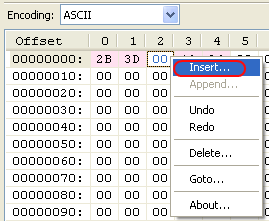

Of the file would appear on precisely one line of tweak's display. This would arrange that after the header, each individual record
#Hex fiend insert bytes series
Series of 22-byte records, you might find it useful to specify the options -w 22 -o 53. For example, if your file contained a 53-byte header followed by a You might use this option if you knew you were editing a file in a particular format. 4.By putting only three bytes of the file on the very first line, tweak has arranged that the file offset 0x13 (19 in decimal) appears at the beginning Options -w 8 -o 0x13, you might see a display a bit like this: 00000000 7F 45 4C. For example, if you loaded a file using the o offset If this option is specified, tweak will ensure that the given file offset occurs at the start of a line. The default is 16, which fits neatly in an 80-column screen. w width Specifies the number of bytes tweak will display per line. Means that it has no dependency on the input file remaining unmodified, and other programs can alter it if they need to without causing trouble. This causes it to take up more memory, but In this mode tweak will read its entire input file when starting up. In this mode tweak does not allow you to modify the data at all it becomes simply a tool for examining a file in Rendering it unusable) and you want to avoid turning it on by mistake. Is of no use (executables, for example, tend to have strong dependencies on precise file offsets which make it almost impossible to insert data in one without This might be useful if you are editing a file in which the insert mode with the insert function entirely disabled. This section lists the command-line options supported by tweak. Therefore, you can disable this lazy loading if you need to see the -e option below. Tweak's internal data structures will not be sufficient to keep track, and it is likely that the file written out will contain a mixture of the old and However, this mode of operation has a disadvantage, which is that if the input file is modified by another program while tweak is running, Only when saving the altered version will tweak have to read through the entire input file to write the output. This means you can edit extremely large files (for example, entire CD images) without difficulty opening such aįile is instantaneous, making modifications causes tweak's memory usage to grow with the size of the changes rather than the size of the whole file, and When you modify the file, it stores your modifications in memory, but continues to refer to the originalĭisk file for the parts you have not touched. Instead, it loads it lazily, reading from the file on disk when you requestĪ view of a part of the file it doesn't have stored. Is narrower - or wider - than the usual 80 columns, or if the file you are editing consists of fixed-size records of some other size.īy default, tweak does not load its entire input file into memory.

However, this is configurable if your screen In fact, when you start tweak, you will usually see 16 bytes of the file per row, not 8 as shown above. The column on the left shows the position within the file of the start of each row.

Subsequent sequence 01 01 01 00 does not have any printable ASCII representation and so the right-hand column simply prints dots. In the example above, the sequence 45 4C 46 on the first line translates into the ASCII upper-case letters "ELF", but the The column on the right shows the ASCII interpretation of thoseīytes, where applicable. The central column shows you the hexadecimal value of each byte in the file you are editing. When you open a file in tweak, you can expect to see the screen contents looking something like this:Ġ0000000 7F 45 4C 46 01 01 01 00. Also, an insert mode makes it easy to use tweak to construct new files from scratch. This is not useful when editing many of the types of file describedĪbove, but can be useful in other situations. Unlike simpler hex editors, tweak possesses a fully functional insert mode. Useful for modifying binary files such as executables, editing disk or CD images, debugging programs that generate binary file formats incorrectly, and many
#Hex fiend insert bytes full
It allows you to edit a file at very low level, letting you see the full and exact binary contents of the file.


 0 kommentar(er)
0 kommentar(er)
